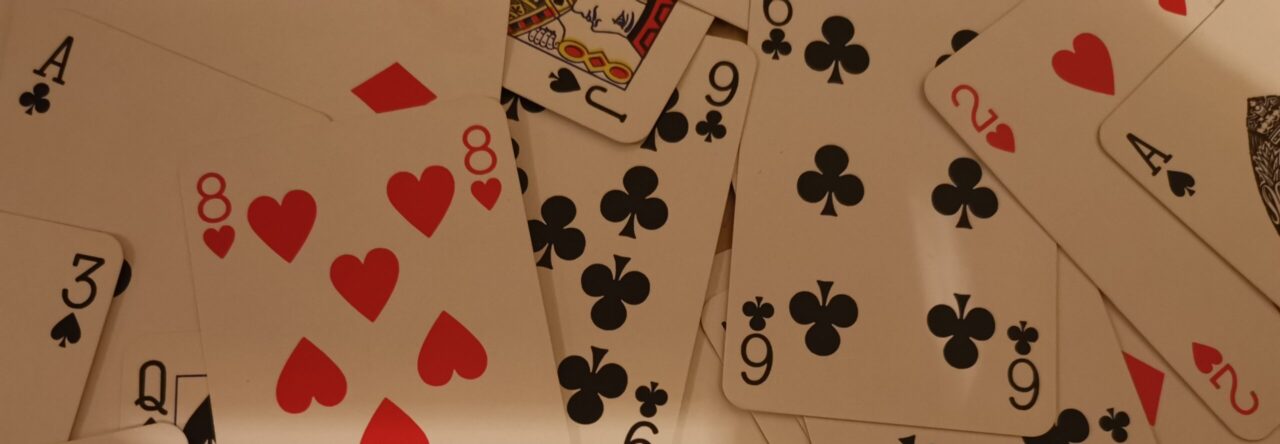This is a bridge acronym standing for:
- Colour
- Rank
- Other
It’s similar to the Unusual NT and the Michael’s cue bid all wrapped in one. I think some people (me) have also called it Modified Ghestem as well.
It’s used to specify 55 distributions when the opponents have opened at the 1 level…the difference is you can specify exactly what suits the 55 are in where you might be left guessing using the Michael’s cue bid.
Same Colour (C)
So the Cue-bid (C) show at least 55 in two suits of the same colour…
| Oppo Bid | Your Bid | Meaning |
| 1♣ | 2♣ | Shows 55 in the red suits |
| 1♦ | 2♦ | Shows 55 in the black suits |
| 1♥ | 2♥ | Shows 55 in the black suits |
| 1♠ | 2♠ | Shows 55 in the red suits |
Same Rank (R)
This time the 2NT bid shows two suits of the same rank. Soif they bid a minor…you have at least 55 in the majors and if they bid the majors then you have the minors again at least 55.
| Oppo Bid | Your Bid | Meaning |
| 1♣ | 2NT | Shows 55 in the majors |
| 1♦ | 2NT | Shows 55 in the majors |
| 1♥ | 2NT | Shows 55 in the minors |
| 1♠ | 2NT | Shows 55 in the minors |
3♣ – The Other bid (O)
This one usually takes a bit more thinking about to work out but it’s easy when you get used to it!
| Oppo Bid | Your Bid | Meaning |
| 1♣ | 3♣ | Shows 55 in diamonds and spades |
| 1♦ | 3♣ | Shows 55 in clubs and hearts |
| 1♥ | 3♣ | Shows 55 in diamonds and spades |
| 1♠ | 3♣ | Shows 55 in clubs and hearts |
So the advantage of using CRO over say the Michael’s Cue Bid is partner knows what the other minor is:-
So if the bidding for example goes:-
Using a Michael’s Cue Bid
| North | East | South | West |
| 1♠ | 2♠ | 4♠ | ? |
Suppose east has made a michael’s cue bid showing hearts and an unspecified minor. West might have a good sacrifice in Clubs but not have a sacrifice in hearts or diamonds…so he’s forced to pass as otherwise he’d be guessing to bid at the 5 level which could be a worse score than them making 4 spades.
This time using CRO
| North | East | South | West |
| 1♠ | 3♣ | 4♠ | 5♣ |
| Pass | Pass | Double | Pass |
| Pass | Pass |
This time West is able to bid clubs and find a good sacrifice…North south collect 300 for the doubled club contract but they could have made 4 spades vulnerable for 620!
The disadvantages of CRO are:
- You tell the opposition what the other minor is
- It’s slightly more stuff to remember
- You lose the 3♣ bid as a natural bid
- The opposition can use the minor as a cue bid as well
It sounds like I’m putting more negatives than positives but personally I think it’s worth it as I’ve found loads of sacrifices in the minors using this system and for me that outweighs the negatives.
Typical hands To use CRO
So these hands you could use CRO to describe your hand
- ♠ 4 ♥ KQ1076 ♦ AJ1073 ♣ 72
- ♠ AJ987 ♥ KJ1086 ♦ J7 ♣ 7
So I tend to visualise a hand with about 10 points
Hands NOT to use CRO
You wouldn’t do it with these hands:
- ♠ AQ ♥ 107654 ♦ J10873 ♣ K
- ♠ AKQ ♥ KJ1086 ♦ 65432 ♣ Void
The first hand you don’t have 10 points in the two suits…but you have some defensive values. The second hand again has a lot of your points in the other major.
